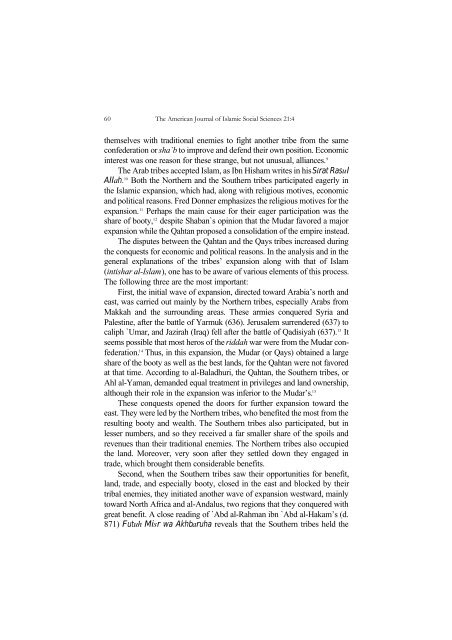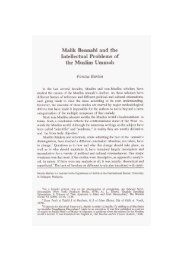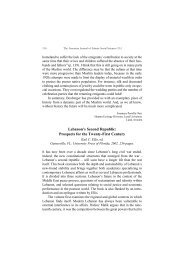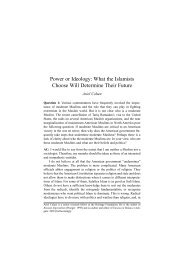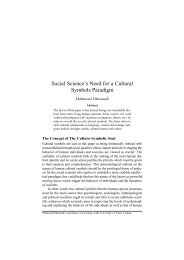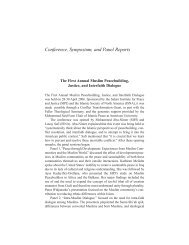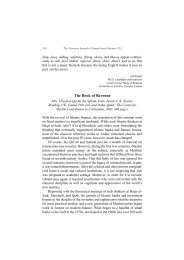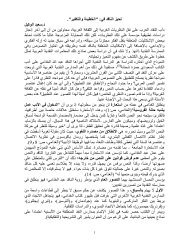Arab Tribes, the Umayyad Dynasty, and the `Abbasid ... - Epistemology
Arab Tribes, the Umayyad Dynasty, and the `Abbasid ... - Epistemology
Arab Tribes, the Umayyad Dynasty, and the `Abbasid ... - Epistemology
Create successful ePaper yourself
Turn your PDF publications into a flip-book with our unique Google optimized e-Paper software.
60 The American Journal of Islamic Social Sciences 21:4<br />
<strong>the</strong>mselves with traditional enemies to fight ano<strong>the</strong>r tribe from <strong>the</strong> same<br />
confederation or sha`b to improve <strong>and</strong> defend <strong>the</strong>ir own position. Economic<br />
interest was one reason for <strong>the</strong>se strange, but not unusual, alliances. 9<br />
The <strong>Arab</strong> tribes accepted Islam, as Ibn Hisham writes in his Sirat Rasul<br />
Allah. 10 Both <strong>the</strong> Nor<strong>the</strong>rn <strong>and</strong> <strong>the</strong> Sou<strong>the</strong>rn tribes participated eagerly in<br />
<strong>the</strong> Islamic expansion, which had, along with religious motives, economic<br />
<strong>and</strong> political reasons. Fred Donner emphasizes <strong>the</strong> religious motives for <strong>the</strong><br />
expansion. 11 Perhaps <strong>the</strong> main cause for <strong>the</strong>ir eager participation was <strong>the</strong><br />
share of booty, 12 despite Shaban`s opinion that <strong>the</strong> Mudar favored a major<br />
expansion while <strong>the</strong> Qahtan proposed a consolidation of <strong>the</strong> empire instead.<br />
The disputes between <strong>the</strong> Qahtan <strong>and</strong> <strong>the</strong> Qays tribes increased during<br />
<strong>the</strong> conquests for economic <strong>and</strong> political reasons. In <strong>the</strong> analysis <strong>and</strong> in <strong>the</strong><br />
general explanations of <strong>the</strong> tribes’ expansion along with that of Islam<br />
(intishar al-Islam), one has to be aware of various elements of this process.<br />
The following three are <strong>the</strong> most important:<br />
First, <strong>the</strong> initial wave of expansion, directed toward <strong>Arab</strong>ia’s north <strong>and</strong><br />
east, was carried out mainly by <strong>the</strong> Nor<strong>the</strong>rn tribes, especially <strong>Arab</strong>s from<br />
Makkah <strong>and</strong> <strong>the</strong> surrounding areas. These armies conquered Syria <strong>and</strong><br />
Palestine, after <strong>the</strong> battle of Yarmuk (636). Jerusalem surrendered (637) to<br />
caliph `Umar, <strong>and</strong> Jazirah (Iraq) fell after <strong>the</strong> battle of Qadisiyah (637). 13 It<br />
seems possible that most heros of <strong>the</strong> riddah war were from <strong>the</strong> Mudar confederation.<br />
14 Thus, in this expansion, <strong>the</strong> Mudar (or Qays) obtained a large<br />
share of <strong>the</strong> booty as well as <strong>the</strong> best l<strong>and</strong>s, for <strong>the</strong> Qahtan were not favored<br />
at that time. According to al-Baladhuri, <strong>the</strong> Qahtan, <strong>the</strong> Sou<strong>the</strong>rn tribes, or<br />
Ahl al-Yaman, dem<strong>and</strong>ed equal treatment in privileges <strong>and</strong> l<strong>and</strong> ownership,<br />
although <strong>the</strong>ir role in <strong>the</strong> expansion was inferior to <strong>the</strong> Mudar’s. 15<br />
These conquests opened <strong>the</strong> doors for fur<strong>the</strong>r expansion toward <strong>the</strong><br />
east. They were led by <strong>the</strong> Nor<strong>the</strong>rn tribes, who benefited <strong>the</strong> most from <strong>the</strong><br />
resulting booty <strong>and</strong> wealth. The Sou<strong>the</strong>rn tribes also participated, but in<br />
lesser numbers, <strong>and</strong> so <strong>the</strong>y received a far smaller share of <strong>the</strong> spoils <strong>and</strong><br />
revenues than <strong>the</strong>ir traditional enemies. The Nor<strong>the</strong>rn tribes also occupied<br />
<strong>the</strong> l<strong>and</strong>. Moreover, very soon after <strong>the</strong>y settled down <strong>the</strong>y engaged in<br />
trade, which brought <strong>the</strong>m considerable benefits.<br />
Second, when <strong>the</strong> Sou<strong>the</strong>rn tribes saw <strong>the</strong>ir opportunities for benefit,<br />
l<strong>and</strong>, trade, <strong>and</strong> especially booty, closed in <strong>the</strong> east <strong>and</strong> blocked by <strong>the</strong>ir<br />
tribal enemies, <strong>the</strong>y initiated ano<strong>the</strong>r wave of expansion westward, mainly<br />
toward North Africa <strong>and</strong> al-Andalus, two regions that <strong>the</strong>y conquered with<br />
great benefit. A close reading of `Abd al-Rahman ibn `Abd al-Hakam’s (d.<br />
871) Futuh Misr wa Akhbaruha reveals that <strong>the</strong> Sou<strong>the</strong>rn tribes held <strong>the</strong>


